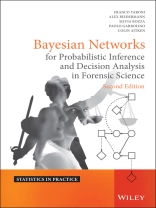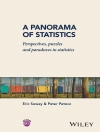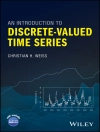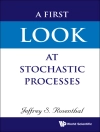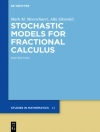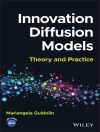Bayesian Networks
‘This book should have a place on the bookshelf of every forensic scientist who cares about the science of evidence interpretation.’
Dr. Ian Evett, Principal Forensic Services Ltd, London, UK
Bayesian Networks
for Probabilistic Inference and Decision Analysis in Forensic Science
Second Edition
Continuing developments in science and technology mean that the amounts of information forensic scientists are able to provide for criminal investigations is ever increasing. The commensurate increase in complexity creates diffculties for scientists and lawyers with regard to evaluation and interpretation, notably with respect to issues of inference and decision. Probability theory, implemented through graphical methods, and specifically Bayesian networks, provides powerful methods to deal with this complexity. Extensions of these methods to elements of decision theory provide further support and assistance to the judicial system.
Bayesian Networks for Probabilistic Inference and Decision Analysis in Forensic Science provides a unique and comprehensive introduction to the use of Bayesian decision networks for the evaluation and interpretation of scientific findings in forensic science, and for the support of decision-makers in their scientific and legal tasks.
* Includes self-contained introductions to probability and decision theory.
* Develops the characteristics of Bayesian networks, object-oriented Bayesian networks and their extension to decision models.
* Features implementation of the methodology with reference to commercial and academically available software.
* Presents standard networks and their extensions that can be easily implemented and that can assist in the reader’s own analysis of real cases.
* Provides a technique for structuring problems and organizing data based on methods and principles of scientific reasoning.
* Contains a method for the construction of coherent and defensible arguments for the analysis and evaluation of scientific findings and for decisions based on them.
* Is written in a lucid style, suitable for forensic scientists and lawyers with minimal mathematical background.
* Includes a foreword by Ian Evett.
The clear and accessible style of this second edition makes this book ideal for all forensic scientists, applied statisticians and graduate students wishing to evaluate forensic findings from the perspective of probability and decision analysis. It will also appeal to lawyers and other scientists and professionals interested in the evaluation and interpretation of forensic findings, including decision making based on scientific information.
Table of Content
Foreword xiii
Preface to the second edition xvii
Preface to the first edition xxi
1 The logic of decision 1
1.1 Uncertainty and probability 1
1.2 Reasoning under uncertainty 12
1.3 Population proportions, probabilities and induction 19
1.4 Decision making under uncertainty 28
1.5 Further readings 42
2 The logic of Bayesian networks and influence diagrams 45
2.1 Reasoning with graphical models 45
2.2 Reasoning with Bayesian networks and influence diagrams 65
2.3 Further readings 82
3 Evaluation of scientific findings in forensic science 85
3.1 Introduction 85
3.2 The value of scientific findings 86
3.3 Principles of forensic evaluation and relevant propositions 90
3.4 Pre-assessment of the case 100
3.5 Evaluation using graphical models 103
4 Evaluation given source level propositions 113
4.1 General considerations 113
4.2 Standard statistical distributions 115
4.3 Two stains, no putative source 117
4.4 Multiple propositions 122
5 Evaluation given activity level propositions 129
5.1 Evaluation of transfer material given activity level propositions assuming a direct source relationship 130
5.2 Cross- or two-way transfer of trace material 150
5.3 Evaluation of transfer material given activity level propositions with uncertainty about the true source 154
6 Evaluation given crime level propositions 159
6.1 Material found on a crime scene: A general approach 159
6.2 Findings with more than one component: The example of marks 168
6.3 Scenarios with more than one trace: ‘Two stain-one offender’ cases 182
6.4 Material found on a person of interest 185
7 Evaluation of DNA profiling results 196
7.1 DNA likelihood ratio 196
7.2 Network approaches to the DNA likelihood ratio 198
7.3 Missing suspect 203
7.4 Analysis when the alternative proposition is that a brother of the suspect left the crime stain 206
7.5 Interpretation with more than two propositions 214
7.6 Evaluation with more than two propositions 217
7.7 Partially corresponding profiles 220
7.8 Mixtures 223
7.9 Kinship analyses 227
7.10 Database search 234
7.11 Probabilistic approaches to laboratory error 241
7.12 Further reading 246
8 Aspects of combining evidence 249
8.1 Introduction 249
8.2 A difficulty in combining evidence: The ‘problem of conjunction’ 250
8.3 Generic patterns of inference in combining evidence 252
8.4 Examples of the combination of distinct items of evidence 262
9 Networks for continuous models 281
9.1 Random variables and distribution functions 281
9.2 Samples and estimates 289
9.3 Continuous Bayesian networks 292
9.4 Mixed networks 306
10 Pre-assessment 314
10.1 Introduction 314
10.2 General elements of pre-assessment 315
10.3 Pre-assessment in a fibre case: A worked through example 316
10.4 Pre-assessment in a cross-transfer scenario 321
10.5 Pre-assessment for consignment inspection 328
10.6 Pre-assessment for gunshot residue particles 335
11 Bayesian decision networks 343
11.1 Decision making in forensic science 343
11.2 Examples of forensic decision analyses 344
11.3 Further readings 368
12 Object-oriented networks 370
12.1 Object orientation 370
12.2 General elements of object-oriented networks 371
12.3 Object-oriented networks for evaluating DNA profiling results 378
13 Qualitative, sensitivity and conflict analyses 388
13.1 Qualitative probability models 389
13.2 Sensitivity analyses 402
13.3 Conflict analysis 410
References 419
Author index 433
Subject index 438
About the author
FRANCO TARONI, University of Lausanne, Switzerland
ALEX BIEDERMANN, University of Lausanne, Switzerland
SILVIA BOZZA, University Ca’ Foscari of Venice, Italy
PAOLO GARBOLINO, University IUAV of Venice, Italy
COLIN AITKEN, University of Edinburgh, UK
